Amon Carter didn’t invent the rivalry between Fort Worth and Dallas, of course. He just inherited it from the likes of Buckley Burton Paddock of the Fort Worth Democrat and David McCaleb of the Dallas Herald.
In fact, some historians say the rivalry predates newspapers and is as old as Panther City itself. Dallas, founded eight years before the military’s Fort Worth, regarded the new civilian settlement of Fort Worth as an economic rival.
No surprise there. Many a rivalry between two cities has resulted from the collision of scarcity and geography: There were only so many settlers, merchants, factories, railroads, highways, military installations, etc. to be distributed between two towns just thirty miles apart.
Each time that Fort Worth secured a limited resource, that meant that Dallas did not. And vice versa.
That’s just business. Nothing personal, y’all.
But it became personal.
Oliver Knight in Fort Worth: Outpost on the Trinity writes that Dallas partisans began to warn passing migrants of the dangers that awaited them in Fort Worth, especially after the Army abandoned the fort in 1853.
For example, when Stephen Terry and his wife were migrating westward from Kentucky in 1854, as they passed through Dallas they were warned that if they settled in Fort Worth they would be scalped by Native Americans.
Mrs. Terry is supposed to have replied, “I’d just as soon be scalped by Indians as stay here and be eaten up by mosquitoes.”
The Terrys proceeded on to Fort Worth.
Likewise, Fort Worth partisans headed off migrants before they reached Dallas and escorted them around Dallas and on to Fort Worth.
Another early factor in the Fort Worth-Dallas rivalry was the rivalry between Fort Worth and Birdville for the seat of Tarrant County. In the second county seat election in 1856 Fort Worth partisans felt that Dallas supported Birdville over Fort Worth. In that election both Fort Worth and Birdville used whiskey to lure voters to the polls. What irked Fort Worth was that Birdville’s barrel had come from Dallas.
No, newspapers didn’t invent the rivalry, but they certainly promoted it.
![]() In autumn of 1871 Fort Worth got a new newspaper: the Democrat.
In autumn of 1871 Fort Worth got a new newspaper: the Democrat.
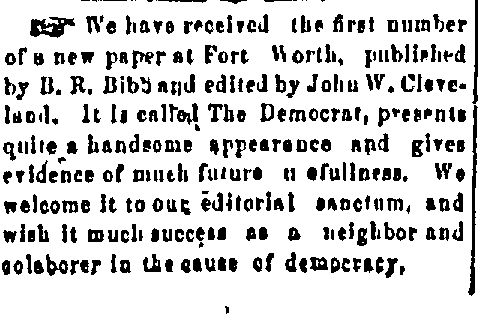 On October 28 the Dallas Herald took note of the new newspaper upriver. The Herald was polite, wished the Democrat well.
On October 28 the Dallas Herald took note of the new newspaper upriver. The Herald was polite, wished the Democrat well.
So far, so good.
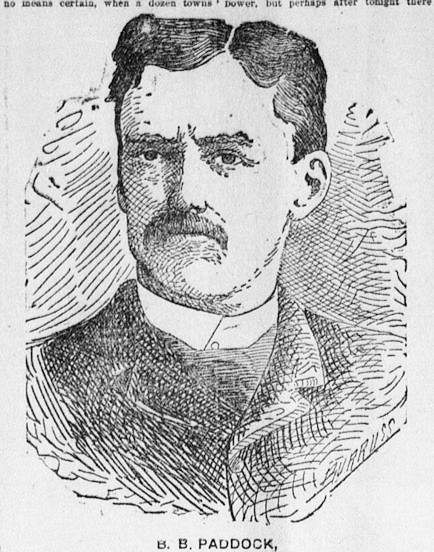 J. W. Cleveland edited the Democrat until early 1872, when B. B. Paddock became editor. Paddock was an unabashed promoter of Fort Worth. Paddock, like most civic leaders in those days, measured his city’s worth in numbers: number of residents, number of factories, number of railroads. Dallas had bigger numbers. Fort Worth was envious.
J. W. Cleveland edited the Democrat until early 1872, when B. B. Paddock became editor. Paddock was an unabashed promoter of Fort Worth. Paddock, like most civic leaders in those days, measured his city’s worth in numbers: number of residents, number of factories, number of railroads. Dallas had bigger numbers. Fort Worth was envious.
Fort Worth was especially envious in the summer of 1872 because Dallas had just gotten its first railroad (Houston & Texas Central) while Fort Worth still had none.
But that was about to change.
The Texas & Pacific railroad had been chartered to connect Texas with the Pacific. As the T&P laid track westward from Longview in the summer of 1873 it was headed straight toward Fort Worth. Paddock was so convinced that Fort Worth soon would be a railroad hub that he drew his tarantula map envisioning Fort Worth with railroad lines radiating like legs of a spider. But just weeks later the economic panic of 1873 caused the T&P to stop laying track at Dallas, leaving Fort Worth’s tarantula without a leg to stand on.
Worse, now Dallas had two railroads to Fort Worth’s none.
As the terminus town on the T&P line Dallas flourished. Fort Worth fumed.
For three long years.
Fort Worth accused Dallas of not wanting the track to be extended west to Fort Worth. Fort Worth accused Dallas of wanting the track to be extended west past Fort Worth to Weatherford, giving Weatherford, not Fort Worth, the economic benefits of being the next terminus town.

The rivalry played out as a public conversation between the Democrat and the Herald via the exchange system employed by newspapers: Newspapers mailed their editions to each other. When the Democrat printed a remark about Dallas, editors at the Herald read the remark, reprinted it in the Herald and replied to the remark in print. And vice versa.
The Herald often addressed Paddock by name. For example, on January 17, 1874 the Herald took “friend Paddock” to task. Paddock had criticized the Herald for predicting that Dallas, not Fort Worth, would become “the great railroad centre of Texas.” Note that the Herald refers to Dallas as “the Queen City of interior Texas.” That title surely rankled Paddock because Fort Worth fancied itself to be “the Queen City of the Prairies.”
Even after the T&P track finally reached Fort Worth in 1876, the hissing continued in the exchanges:
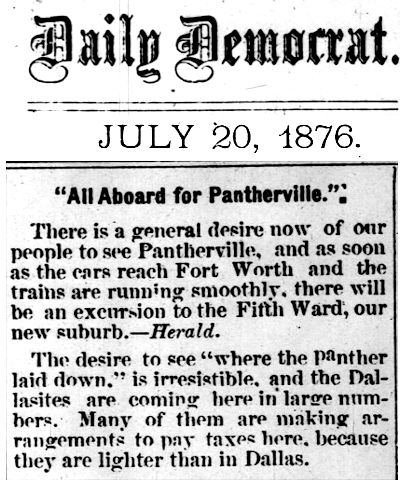 In the July 20 issue the Democrat reprinted a Dallas Herald barb referring to Fort Worth’s Fifth Ward as the new “suburb” of Dallas. In turn, the Democrat predicted that Dallasites would be moving to Fort Worth because of the “higher” taxes in Dallas.
In the July 20 issue the Democrat reprinted a Dallas Herald barb referring to Fort Worth’s Fifth Ward as the new “suburb” of Dallas. In turn, the Democrat predicted that Dallasites would be moving to Fort Worth because of the “higher” taxes in Dallas.
 On July 21, 1876, two days after the first train arrived in Fort Worth, the Herald called Fort Worth a “village.” The Democrat hissed back, calling Dallas “Cougartown” and taunting Dallas with the proposition that its merchants would relocate to “Pantherville,” the new terminus town. Then, in response to a report by the Democrat that two deer had been seen on a Fort Worth street, the Dallas Commercial newspaper tag-teamed with the Herald, suggesting that Fort Worth lease itself for hunting. The Democrat responded by taking another swipe at Dallas and suggesting that Dallas lease itself for cattle pastures.
On July 21, 1876, two days after the first train arrived in Fort Worth, the Herald called Fort Worth a “village.” The Democrat hissed back, calling Dallas “Cougartown” and taunting Dallas with the proposition that its merchants would relocate to “Pantherville,” the new terminus town. Then, in response to a report by the Democrat that two deer had been seen on a Fort Worth street, the Dallas Commercial newspaper tag-teamed with the Herald, suggesting that Fort Worth lease itself for hunting. The Democrat responded by taking another swipe at Dallas and suggesting that Dallas lease itself for cattle pastures.
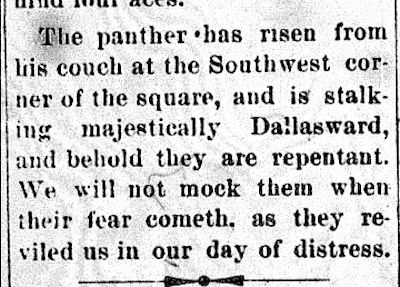 A week later Paddock seemed to be framing the rivalry in Old Testament terms: “. . . and behold they are repentant. We will not mock them when their fear cometh.” Holy Moses, Paddock! Picture ol’ B. B. wearing tunic and sandals and a flowing white beard, perhaps pausing in his hissing at Dallas only long enough to part the waters of the Trinity River.
A week later Paddock seemed to be framing the rivalry in Old Testament terms: “. . . and behold they are repentant. We will not mock them when their fear cometh.” Holy Moses, Paddock! Picture ol’ B. B. wearing tunic and sandals and a flowing white beard, perhaps pausing in his hissing at Dallas only long enough to part the waters of the Trinity River.
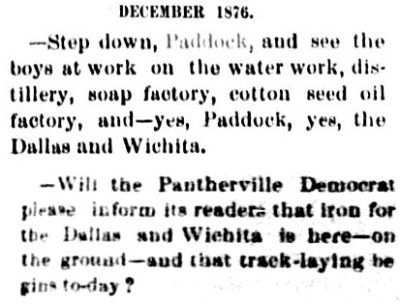 Paddock and Fort Worth got six months to celebrate narrowing the railroad gap with Dallas from 2-0 to 2-1 before the Herald began taunting Paddock about all the construction under way in Dallas, especially on its third railroad.
Paddock and Fort Worth got six months to celebrate narrowing the railroad gap with Dallas from 2-0 to 2-1 before the Herald began taunting Paddock about all the construction under way in Dallas, especially on its third railroad.
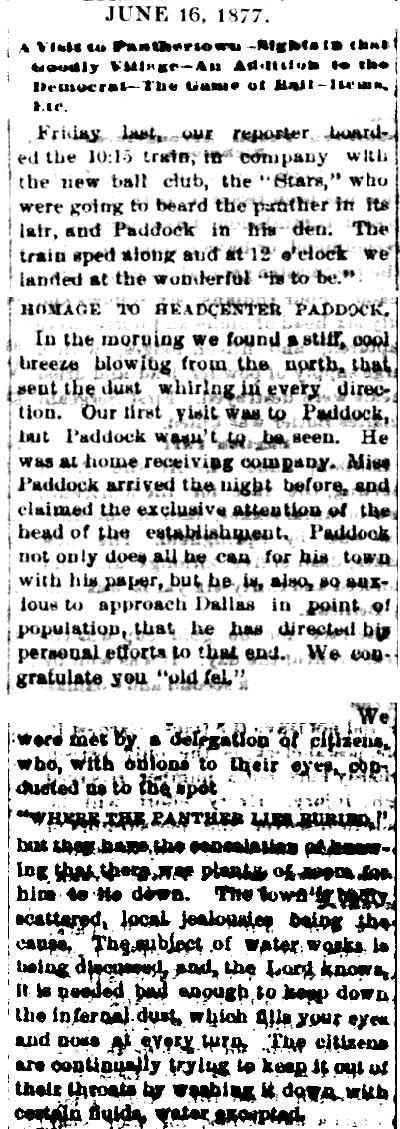 Fast-forward six months. On June 16, 1877, the Herald made “a visit to Panthertown.” One of its reporters had accompanied a Dallas baseball team to the “village” of Fort Worth to “beard the Panther in its lair, and Paddock in his den.” The Herald referred to Fort Worth as “the wonderful ‘is to be’” and made light of Paddock’s desire for Fort Worth to catch up with Dallas in population. It wrote that Fort Worth “is badly scattered, local jealousies being the cause,” and commented on the town’s “infernal dust,” which its “citizens are continually trying to keep . . . out of their throats by washing it down with certain fluids, water excepted.”
Fast-forward six months. On June 16, 1877, the Herald made “a visit to Panthertown.” One of its reporters had accompanied a Dallas baseball team to the “village” of Fort Worth to “beard the Panther in its lair, and Paddock in his den.” The Herald referred to Fort Worth as “the wonderful ‘is to be’” and made light of Paddock’s desire for Fort Worth to catch up with Dallas in population. It wrote that Fort Worth “is badly scattered, local jealousies being the cause,” and commented on the town’s “infernal dust,” which its “citizens are continually trying to keep . . . out of their throats by washing it down with certain fluids, water excepted.”
Referring to the origin of Fort Worth’s nickname “Panther City” two years earlier in the Herald, the Herald report said the panther that once “laid down” in sleepy Fort Worth was now dead and buried.
The panther might have been dead and buried, but the Panther City-Big D rivalry seemed to be pert near immortal.
Or was it?
At least one attempt was made to bury the hatchet—literally:
When “RIP” Stands for “Rivals in Perpetuity”
Related posts:
11:23 a.m. (Part 3): Panther That, Cougartown!
On This Date in Hisstory: Meow!





